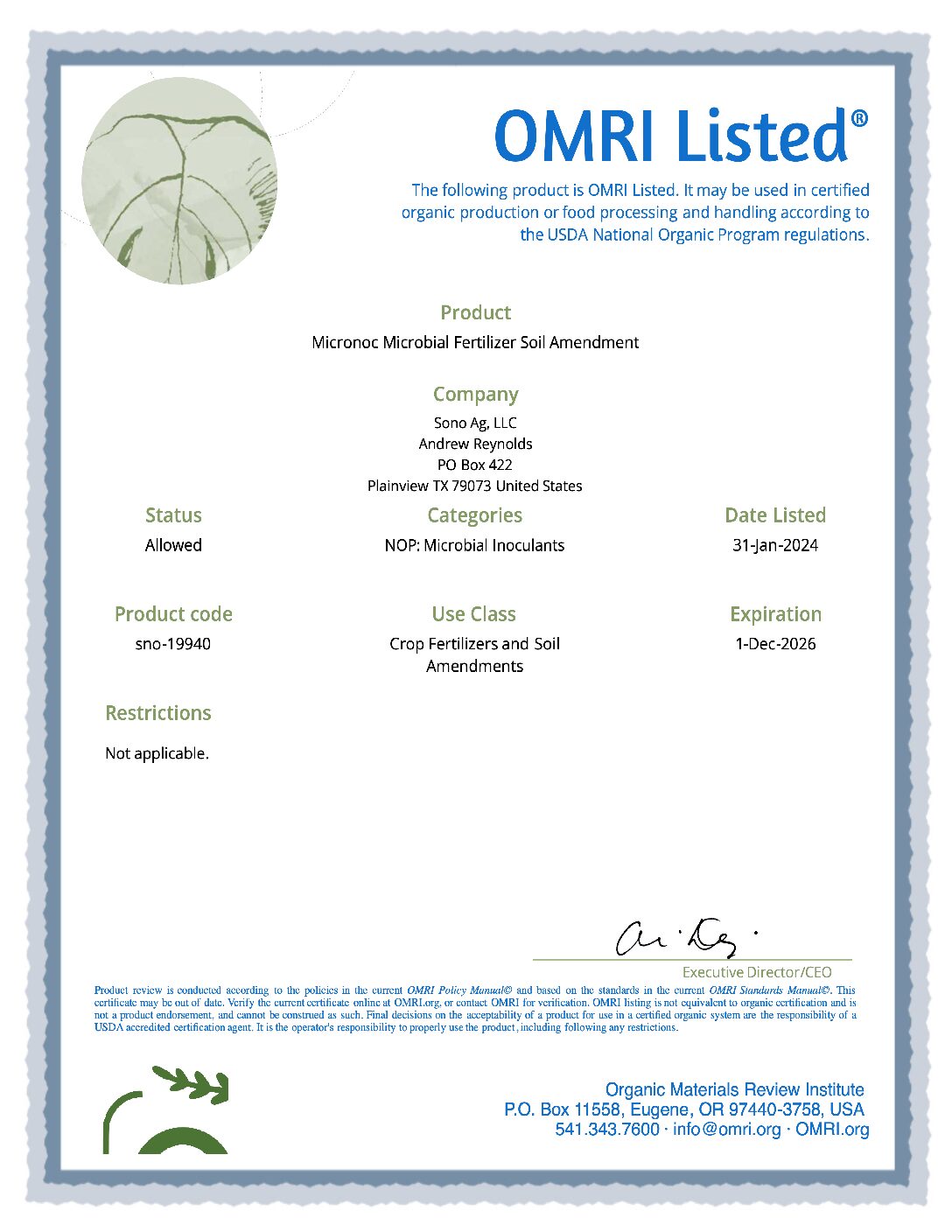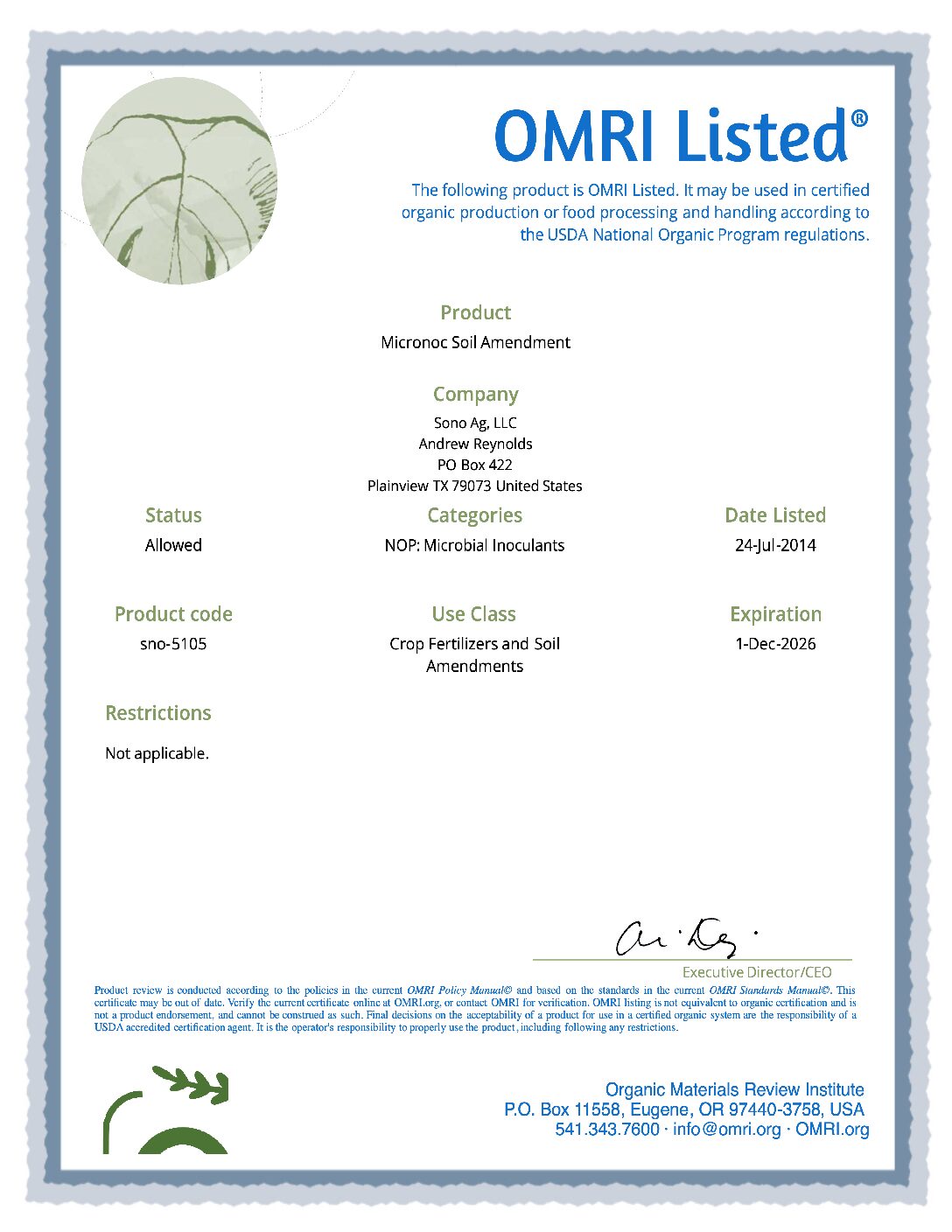Research
Micronoc Seed Inoculant
“If you want your seed to perform the best, use the best.”
Welcome to Sono Ag, where innovation meets agriculture. Our Micronoc Seed Inoculant is more than just a dry seed treatment; it’s a game-changer in the world of sustainable farming.
About Micronoc Seed Inoculant
Micronoc is an OMRI listed dry seed treatment meticulously crafted with multiple strains of rhizobium, bacillus, and azotobacter, combined in a humate powder. This powerful blend of beneficial microbes enhances soil health, maximizes nutrient uptake, and promotes robust plant growth.
Customizable and Powerful
Not only is Micronoc the key to unlocking your soil’s potential, but it’s also highly customizable. Tailor your order to meet the specific needs of your soil, ensuring your crops receive the exact nutrients they need to thrive.
Optimal Application
For all your planting needs, Micronoc recommends an application rate of 1 pound per 5 acres. Simply coat the seeds and plant as soon as possible after coating for optimal results..

Research Papers
2020 MicroNoc Corn Trial Results
Matt Griggs, President
Griggs Farms LLC
Texas Tech University
College of Agricultural Sciences & Natural Resources
Fiber & Biopolymer Research Institute
Micronoc Research (click here to view)
Review from James Twigg-Smith
“Here’s a picture of the roots of our sunflower treated with the liquid at planting. When I first saw the roots sticking up out of the ground, I thought it was a white mold layer developing, but was the roots! Biggest root system we have ever seen. This field was cultivated, so soil was pushed up against the stalks, but very impressed with the results.” – James Twigg-Smith. Kaumakani, Hawaii

Micronoc Soil Amendment
About Micronoc Soil Amendment
Micronoc Soil Amendment is an OMRI listed allowed organic fertilizer that is a balanced blend of beneficial microorganisms selected for their ability to decompose organic matter, fight pathogens, diseases, fix atmospheric nitrogen, and increase yields. This powerful blend of beneficial microbes helps to restore soil health and fertility, improving the overall quality of the soil. By improving the soil structure, Micronoc helps to increase water retention, reduce erosion, and promote healthy root growth. Additionally, Micronoc helps to reduce the need for chemical fertilizers, providing a more sustainable and eco-friendly solution for your soil. With Micronoc, you can be sure that your soil is in the best condition possible for optimal plant growth and yields.
The Advantages of using Micronoc Soil Amendment:
- Uniform Seed Germination
- Increased Root Formation
- Higher Nutrient Utilization
- Earlier Maturity
- Stronger Fruiting and Blooming
- Higher Production Grade
- Increased Yield Volumes
The recommended application rate is 1 gallon per acres.
Understanding Micronoc’s Microbial Product Line
Micronoc’s microbial product line harnesses the power of microorganisms to enhance soil health and plant growth. From Azotobacter to Bacillus and Rhizobium to Mycorrhizal Fungi, each component plays a crucial role in creating a healthy soil ecosystem.
Basic Line-Up

Azotobacter-(multiple species)
Azotobacter(multiple strains) fixes atmospheric nitrogen for all plant types. Has one of the highest respiration rates of all microbes. Known to fix up to 60-80 lb of nitrogen per acre in a growing season. The great thing about this critter is that it will fix N independent of a plant relationship.

Bascillus (multiple species)
Bacillus (multiple species) produce digestive enzymes to break down organic matter and process nutrients into plant ready forms. They also act as a natural pesticide for both larval and soil pathogens.

Rhizobium (multiple species)
This bacteria works with Legumes to fix nitrogen into the soil. We have a species that fix nodules for most Legumes on the market, including Guar. Unlike Azotobacter, Rhizobium is dependent on a plant relationship.

Mycorrhizal Fungi (AMF- Multiple Species)
AMF process phosphorous, protect roots from pathogens, increase water retention, and develop a communication network among plants in the field. They also give plants more greater access to nutrients.

Azotobacter chroococcum
Using Azotobacter chroococcum on your plants and soil can significantly enhance plant growth by fixing atmospheric nitrogen, making it readily available for plant uptake. This beneficial bacterium also improves soil structure and fertility, leading to healthier soil ecosystems. Its application can result in increased crop yields and reduced need for chemical fertilizers, making it an eco-friendly choice for sustainable agriculture.

Bradyrhizobium japonicum
Incorporating Bradyrhizobium japonicum into your soil can significantly boost the growth of legume crops, such as soybeans, by facilitating symbiotic nitrogen fixation, which naturally enriches the soil with nitrogen. This process reduces the dependency on synthetic fertilizers, promoting a more sustainable and environmentally friendly agricultural practice. The enhanced nitrogen availability in the soil leads to healthier plants with increased yields, making Bradyrhizobium japonicum an essential component for optimizing legume crop production and soil health.

Bacillus megaterium
Using Bacillus megaterium on your plants, soil, and seeds can significantly enhance phosphorus availability, a crucial nutrient for plant development, leading to stronger root systems and improved growth. This bacterium’s ability to solubilize phosphorus from soil compounds means plants can more efficiently absorb this essential nutrient, promoting higher yields and healthier crops. Additionally, treating seeds with Bacillus megaterium can kickstart seedling growth by providing an immediate nutrient boost, setting the foundation for a successful growth cycle and sustainable agricultural practices.
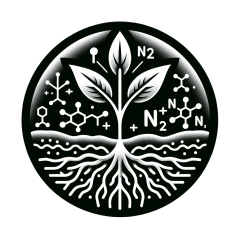
Azotobacter vinelandii
Using Azotobacter vinelandii on your plants and soil can lead to enhanced nitrogen availability, promoting healthier and more robust plant growth without the need for synthetic fertilizers. This bacterium’s ability to fix atmospheric nitrogen into a form accessible to plants improves soil fertility and structure, fostering a more sustainable agricultural environment. Additionally, its contribution to the natural production of growth-promoting substances and vitamins benefits both plants and the microbial health of the soil, further supporting ecological balance and crop productivity.

Azospirillum brasilense
Applying Azospirillum brasilense to your plants, soil, and seeds can significantly enhance root development, leading to improved nutrient and water uptake. This bacterium’s ability to fix atmospheric nitrogen and solubilize phosphorus directly benefits plant growth, reduces the need for chemical fertilizers, and promotes a healthier, more sustainable agricultural practice. The early inoculation of seeds with Azospirillum brasilense jump-starts germination, establishes a robust root system from the outset, and ultimately results in increased crop yields and resilience against environmental stresses.
What is Micronoc?
Micronoc is an active part of the soil, composed of a balanced blend of beneficial microorganisms. These microorganisms, selected for their unique abilities, improve soil structure, retain water, decompose organic matter, fight pathogens, stimulate root development, and fix atmospheric nitrogen.
N-P-K
N-P-K and trace minerals are crucial, but Micronoc goes beyond, emphasizing the importance of other essential elements such as calcium, magnesium, and sulfur. Incorporating organic matter into the soil ensures a slow release of nutrients, improving soil structure and reducing water and fertilizer loss.
Nitrogen Utilization
Micronoc emphasizes the importance of nitrogen and how microorganisms like Azotobacter and Rhizobium play a vital role in fixing and making nitrogen available to plants.
Phosphorus Availability
Phosphorus, essential for healthy plant growth, is made available through mineralization, a process facilitated by microorganisms.
Potassium (Potash)
Potassium, vital for plant development, is released through the processes of aerobic microorganisms.
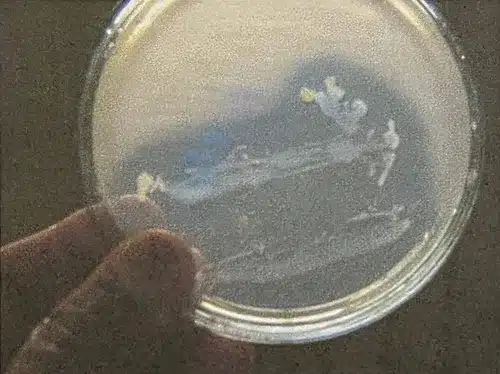

Nitrogen fixing Azospirillum bacteria growing in Azospirillum medium, note the blue color development due to production of NH4+ during nitrogen fixing process.
Information and photo from D.Hettiarachchi Consultant Industrial Microbiologist B.Sc(Biol.).PGD (Indust.Mcb),M.Sc.(Indust.Mcb)
Examples of when proper microorganisms made these nutrients plant ready.
In the following photos you will see examples of crops that had nutrients made available. All of the examples are third party grow, production crop photos. These are not lab samples. The only way to test a production product is under real world situations and production growing methods.

Example: Increased Nitrogen Utilization from Atmospheric and Soil sources.
Spring Wheat North Dakota Perfect example of atmospheric nitrogen fixation and utilization.
100 pounds anhydrous ammonia application
Micronoc Application
Example: Increased Nitrogen, Phosphorus and Potassium
(N)(P) are both need for increased fruiting.
Corn Halfway Texas August 2014 Corn is the same variety and planted on the same day, in the same field, with the same fertilization program excluding the use of Micronoc. The crop is still out.

6 ear average of 497 kernels per ear.
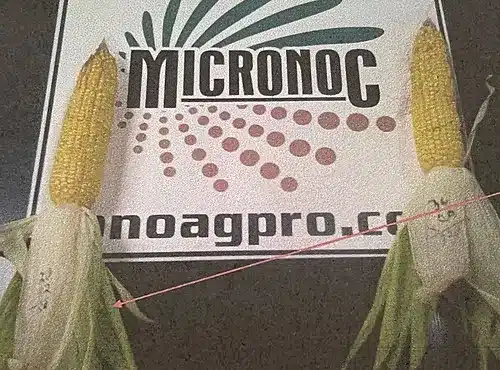
6 ear average of 724 kernels per ear. (K) Helps water retention within the plant.
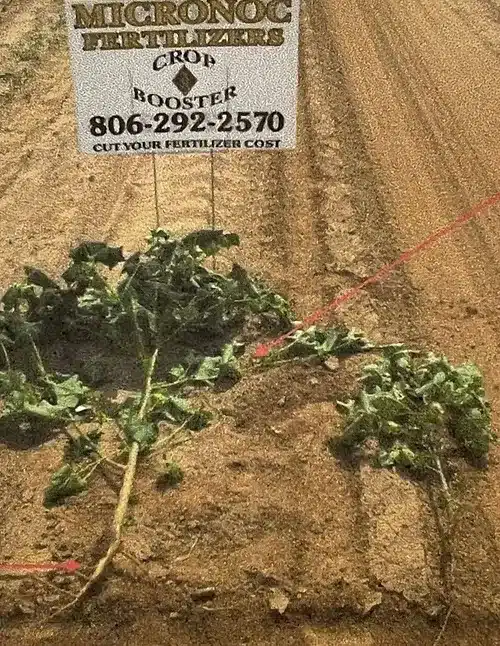
Cotton Barwise Texas,
Micronoc out yielded the control 3.6 bale to the acre verses 2.1 bale to the acre.
This is another but more profound example of more total nutrient availability in a crop that requires higher P-K levels for production.
Larger Root Mass
Higher Fruiting
Carrots Southern California
For a plant to maintain energy for healthy growth it must have a good combination of all required nutrients. It is simple, better nutrients means a better plant and better fruits.
The control plot had to cull 36 out of 100 carrots sampled. Micronoc had 23 culled carrots from 100. That is 13% higher quality yield.

Micronoc Treated

Control
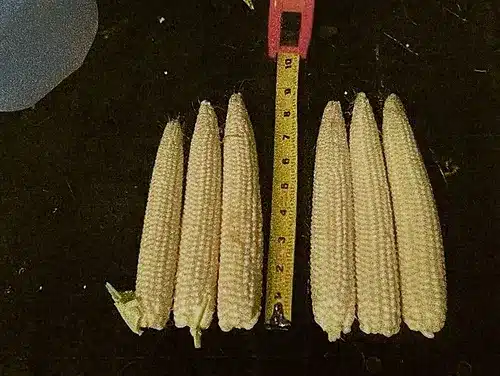
Corn IFR Test farm Yuma ,Co
In the 2013 test Micronoc out yielded the control by 6.9 bushels per acre. Photo was taken on August 13, 2013
Control
Micronoc
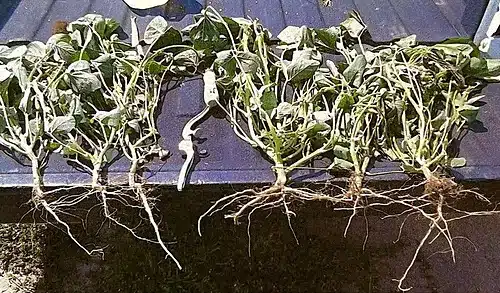
Root formation Yuma Co. Soybeans
Notice the development of the Micronoc plants both in the root and tissue. It is clear to see that a better root makes a better plant. The field trial Micronoc yielded 6.9 bushels higher.
Control
Micronoc
Third Party Testing
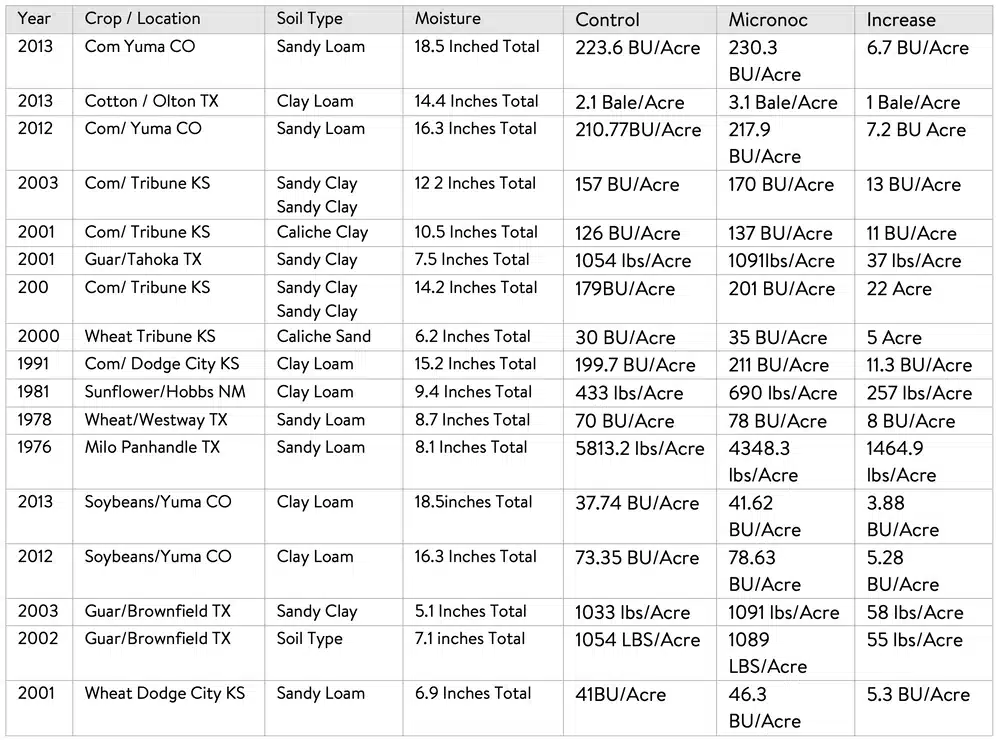
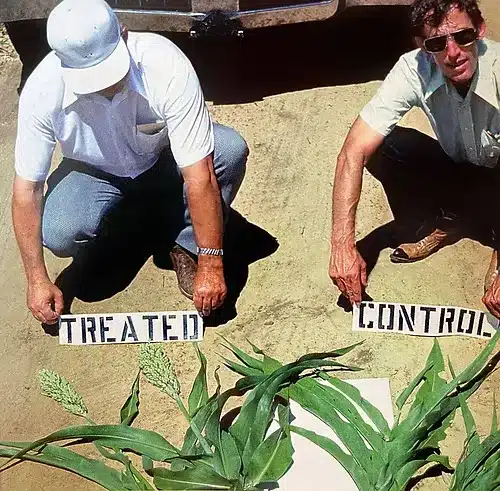
Brownfield Texas 1975. Alfred Lee Reynolds Developer of Micronoc.
As seen in this photo from 1975, the use of microorganisms to increase soil effectiveness has been done for many decades now. Over the last 40 years Micronoc has been used on millions of acres all over North America on all kinds of crops. Micronoc usage has primarily been in production agriculture.
The utilization of soil biology is the future of agriculture.
The organic food movement of the early 2000s brought awareness of soil health/biology to the mainstream, as organic production became more efficient and profitable. The internet has made the exchange and availability of biological information much easier to gain, and in the first 35 years of Sono Ag products, this information was only spread by word of mouth. Mainstream fertilizer companies did not put out this information, but private and government agencies have started to realize that the current agricultural model is not self-sustaining and cannot provide healthy and abundant food for the growing world population.
In response, businesses and universities are now focusing on soil biology, in addition to plant and seed varieties, to help solve this problem. This shift in focus is driven by the need for sustainable and healthy food production, rather than the profitability of selling and developing GMO seeds. By understanding and utilizing the biology of the soil, we can create a more sustainable and productive agricultural system that can provide healthy and abundant food for the world.
Sono Ag has a significant competitive advantage with Micronoc.
Sono Ag utilizes microorganisms that were isolated from virgin soils, many of which have been reproduced from specimens isolated in the early 1970s. This provides a significant competitive advantage, as virgin soil is difficult to find in agricultural areas, and once soil is exposed to high levels of tillage and chemicals, the biological profile is permanently altered. This makes it highly unlikely that the proper microbes to replicate Micronoc can be isolated. Furthermore, the agricultural community has not focused on soil biology for the last 40 years, further increasing the barriers to competitors.
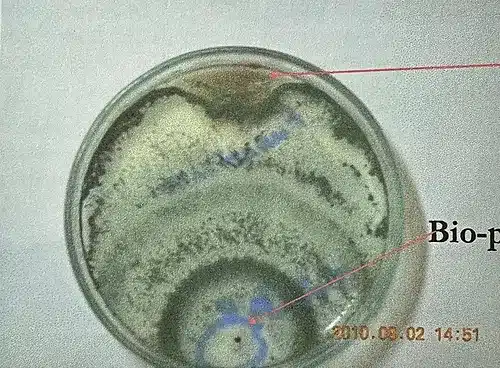
Disease control by biological means!
The slide was inoculated with Trichoderma viride and Fusarium sp at the same time. AS you can see the green Trichoderma controlled the spread of the Fusarium. This is just one of the many bio controls available.
Fusarium sp
Bio-pesticide Trichoderma viride
Information and photo from D. Hettiarachchi Consultant Industrial Microbiologist B Sc(Biol.).PGD (Indust Mcb), MSc Indust Mcb)
Barriers to Competitors Manufacturing Processes
Sono Ag has perfected its manufacturing processes over the years, using specialized techniques to ensure the proper balance of species in its products. This balance is essential for the product’s viability, and any slight change can cause degeneration of the finished product. To maintain this balance, Sono Ag must carefully control a range of variables, including food source and timing, pH, temperature, and timing of product blending. All of these variables have been tested and refined over the years, and any alteration can drastically affect the product’s quality.
Micronoc Competitive Advantages to Other Soil Amendments
Most Biological soil amendments focus on a single soil function, such as the release of stored nutrients. While these amendments can break down organic matter at very high rates and release bound NPK, they are often made up of over aggressive bacteria that are not soil born, which can have severe long-term effects by destroying the natural populations of the soil. When soil organic matter is broken down to very low levels, the soil loses the ability to hold moisture, run off increases, natural nitrogen fixation drops, and more fertilizer will be required.
An alternative to these amendments are products that focus on Mycorrhizae Fungi. Micronoc products contain Mycorrhizae spores as part of the balanced product and do not rely on them solely for soil enrichment. These products use only soil born organisms which support multiple soil functions such as nitrogen fixation, decomposition, disease protection, growth stimulation, water retention, and root formation. This ensures that the soil is enriched in a balanced and sustainable way, without the risk of long-term damage.
Micronoc Competitive Advantages To Compost Tea
- Compost teas have been used for centuries and have some agricultural benefits. However, since the introduction of animal antibiotics compost tea is not the same. 60% of all antibiotics given to production animals is excreted out in the manure. Unless these antibiotics are thermo digested they will be passed onto the soil. Furthermore, the bacteria found in compost tea cannot be more diverse than the bacteria found in the feed. If the feed is not raised on biologically diverse soil, then the manure will not be diverse.
- The manufacturing processes of most Compost Teas are not regulated. If they are using open air tanks, they could be culturing several soil or airborne pathogens from numerous uncontrolled sources. These can be harmful to plants and people. Recently, there have been new restrictions placed on the use of compost tea on food crops due to the risk of illness and death by consumers.
“When you are running cows in the desert of West Texas, you need all the help you can get. By planting a drought tolerant grass and incorporating the Sono AG product for past year, I have seen a huge difference in my pasture. It requires less fertilizer, less water, and my cattle are much more productive.”
Jim Ridenour, DVM

“Great Products Increased my grade production Significantly. Provides a longer boost in growth than a single fertilizer application.”
E.C. Harlin
Micronoc Competitive Advantages to Seed Inoculants
Micronoc is the only inoculant on the market that takes inoculation to new levels by adding more than just Rhizobium. It includes Mycorrhizae Fungi to increase water utilization, potassium uptake and fight root disease, Azotobacteria to fix atmospheric nitrogen for both legume and non-legume plants, and bacillus strains to utilize soil nutrients early in the growing season. Furthermore, it uses specifically isolated Rhizobium for Guar production, and has been repeatedly and consistently shown to produce nodulation on Guar in the US.

